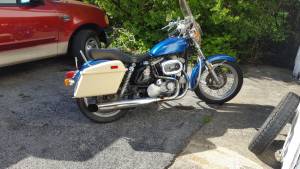Table of Contents
This is an old revision of the document!
1977 Sportster
- Vehicle Identification Number (VIN) is stamped on the right side of the engine crankcase and on the frame steering head.
- 3A13675H7 is a 1977 XLH.
| Model Code | Model Number | Serial Number | Manufacturer ID | Model Year |
| XLH | 3A | 10,000 and up (5digits) | H (for Harley Davidson) | 7 (1977) |
| XLCH | 4A | 10,000 and up (5digits) | H (for Harley Davidson) | 7 (1977) |
| XLCR | 7F | 10,000 and up (5digits) | H (for Harley Davidson) | 7 (1977) |
| XLT | 2G | 10,000 and up (5digits) | H (for Harley Davidson) | 7 (1977) |
Specifications
Models
XLT 1000 Touring
Dimensions
Engine - 1000 cc
Drivetrain
- Primary Drive: Triple- Row Chain
- Primary Drive Front Gear: 34 Teeth 12)
- Primary Drive Rear Gear: 59 Teeth 13)
- Primary Drive Ratio:
- Final Drive: Secondary Drive Chain
- Final Drive Transmission Sprocket: 21 Teeth 14)
- Final Drive Rear Wheel Sprocket: 51 Teeth 15)
- Final Drive Ratio:
- Transmission- Trap Door Style, Constant Mesh Type 4-speed 16)
- Gear Ratios (overall)
- Performance
- Engine Torque Testing Method:
- Engine Torque: 52 ft-lb @ 3,800 rpm 21)
- Lean Angle, Right (deg.):
- Lean Angle, Left (deg.):
Ignition
Fuel System
- Carburetor: 38mm Keihin butterfly (non-CV)
- Carburetor Serial Number: 27153-77
- Carburetor Main Jet: 130, 135, 145, 150, 155, 160, 165, 170, 175
- Carburetor Slow Jet: 0.75 mm
- Engine Idle Slow Speed: 900 RPM
- Engine speed for setting ignition timing: 1050 - 1500
- Fuel Tank Capacity: 3.6 US Gallons 27)
- Oil Tank Capacity w/Filter: 3 qt / 2.8 liters 28)
What is the Current KBB Value? 29)
 |
| 1977 XLT-1000 30) |
XLCR 1000 Cafe Racer
What's the Current KBB Value? 31)
XLH 1000
What is the Current KBB Value? 32)
1977 Sporster 1000 Confederate Edition
- Confederate Edition Sportsters were sold for the 1977 season only.
- This was a limited edition paint scheme sold on select standard XLH/XLCH and XLT models.
- There were reportedly no changes mechanically speaking for this special limited addition to the lineup.
There is very little documentation on the Confederate Edition which is accepted as due to it's controversial overtones. - Paint scheme: 33)
- Charcoal Silver.
- Rebel flag decal R(61650-77) and L(61651-77) on each side of the gas tank.
- Front fender decal (59100-77) resembling the insignia that was on the caps of the Confederate soldiers during the Civil War.
- Additionally there were a reported 44 Harley Confederate FLH motorcycles and 228 Harley Confederate Super Glide motorcycles. 34)
- The Sportster parts catalogs only list the Confederate decals for the XLH and XLCH.
- However, the total Confederate model production numbers are listed here as: 35)
- XLH 1000 (299)
- XLCH 1000 (45)
- XLT 1000 (15)
- Claimed power: 61hp @ 6,200rpm
- Top speed: 115 mph
- Engine type: 997cc (1000) OHV, air-cooled V-twin
- Weight: (wet) 220kg (485 lbs)
- Price then: $3,127
- MPG: 44
Disavowed by the factory for years, and unknown even to most Harley riders, 1977’s Confederate Editions are a fascinating footnote in the history of Harley-Davidson. 1977 was an interesting time in America. The year before, citizens had been giddy with patriotic pride as the entire population settled into a year-long celebration of the country’s bicentennial. Patriotic expressions were the order of the day, and naturally, manufacturers got into the act as well. Harley-Davidson introduced special “Liberty Editions” of it's bikes featuring red, white and blue detailing, while Ford marketed a special red, white and blue Pinto. As it happens, it was also the heyday of “Southern Rock.” Bands like Lynyrd Skynyrd, The Allman Brothers, Black Oak Arkansas and Marshall Tucker were the new cultural vogue, regularly showcasing their roots in visual shorthand with large confederate flags as backdrops for their stages. The rise of Southern Rock gave the South a new cultural cachet, while also unfortunately spawning Billy Beer, Hee Haw and, in 1979, The Dukes of Hazzard. So what’s this have to do with motorcycles? For Harley-Davidson, it was the motivation behind the most unknown model in the company’s history. In 1976, motorcycle sales were booming, thanks in large measure to a continuing oil crisis. The lion’s share of product came from Japan, the once-great British bike industry limping to a self-inflicted death from outdated technology, short-sighted management and recurring labor strikes. But the Big Four — Honda, Kawasaki, Yamaha and Suzuki — were enjoying unparalleled success with their less expensive, technologically superior twins and fours. Harley-Davidson, which held 21 percent of the over-700cc market in the U.S., was already charging Japan with “dumping” — selling motorcycles cheaper in the states than other markets. That’s what John Davidson, then-president of Harley-Davidson, alleged in the early 1970s when the motorcycle business was doing well world-wide. “The Japanese established production schedules that were much higher than mid-Seventies demand for their products,” he contended. “They chose the U.S. to unload their excess production.” (Following strong lobbying from H-D, on April 1, 1983, the International Trade Commission imposed new tariffs on all Japanese motorcycles 700cc and above.) Harley-Davidson was still in an unhappy alliance with American Machine and Foundry (AMF) that would continue until a company buyback in 1981. The 1969 merger with AMF had brought engineering and marketing experience, as well as a generous influx of cash. Unfortunately, federal mandates meant much of the engineering money was directed toward safety and anti-pollution features, not new product development.
More on this article here at the Motorcycle Classics Website
What is the Current KBB Value? 37)
Links to more reading material on the Confederate Editions:












